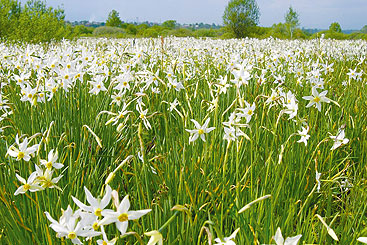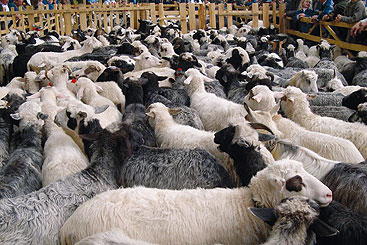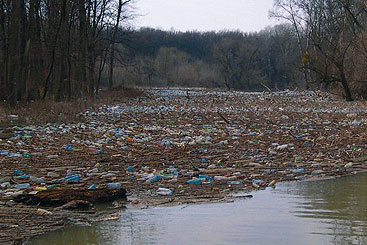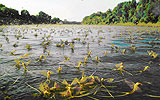
The Tisza River Basin gets a new focus on wetlands
After 15 years of working in the Danube River Basin, UNDP/GEF is now focusing on applying lessons learnt to a smaller scale – The Tisza River Basin. As the largest tributary of the Danube the Tisza is hardly small by European standards!

The Tisza River Basin provides a high diversity of habitats for plants and animals – some of which are no longer found in other parts of Europe. Furthermore, countries in the Tisza River Basin have set aside a significant amount of protected areas and national parks, including nature reserves and several Ramsar sites.
The Tisza River basin is one of the most picturesque regions in europe. Mountain streams, meandering rivers and diverse landscapes are home to many unique species. The last 1 0 years of human influence, however, have caused serious problems for the basin’s waters – including the threat of pollution from organic substances from municipalities and urban settlements, nutrients from wastewater and farming and hazardous substances from industry, mining and agriculture.
Changes in land-use and river engineering have modified the natural structure of the river and resulted in the loss of over 80% of the area’s natural floodplains and wetlands. These changes have led to an increase in extreme events, such as severe floods, periods of devastating droughts (particularly in Hungary and Serbia) as well as landslides and erosion in the uplands. A new project supported by the Global Environment Facility through the United Nations Development Programme (UNDP/GEF) will focus on developing the environmental benefits of wetlands to mitigate impacts of floods/droughts and help to reduce nutrient pollution in the Tisza River Basin.
The project, called ‘Integrating multiple benefits of wetlands and floodplains into improved transboundary management for the Tisza River Basin’ or Tisza River Basin MSP for short, will run for three years. The project is expected to encourage the countries of the Tisza Basin to integrate wetlands into river basin management planning by highlighting the multiple benefits of wetlands in flood protection, drought alleviation and nutrient reduction, as well as their important role in biodiversity.
Sharing experiences. UNDP/GEF is interested in looking at how the activities developed at the Danube level through the successful UNDP/GEF Danube Regional Project can be scaled down and how these more detailed lessons can be replicated elsewhere – especially by increasing the value of wetlands to protect against floods and reduce nutrients. ‘The eyes of Europe will be on the work in the Tisza on this exciting and innovative approach,’ said Helmut Blöch, Deputy Head of Water, Chemicals and Cohesion Unit at the European Commission’s Directorate General for the Environment.
THE TISZA RIVER BASIN AT A GLANCE
Size of the Tisza River basin: 157,186 km²
Length of the Tisza River: 966 km
Percentage of the Tisza basin
in the Danube River basin: 19.5%
Population living in
the Tisza River Basin: 14 million
Largest tributaries: Maros/Mures, Körös/Cris,
Sajó/Slaná, Bodrog and Szamos/Somes
The Tisza River Basin is the largest sub-basin in the Danube River Basin, draining over 157,186 km², and includes territory in Hungary, Romania, Serbia, Slovakia and Ukraine. The Tisza River, at 966 km, is also the longest tributary of the Danube and the second largest by flow, after the Sava River.
The project is a partnership between the countries of the Tisza River Basin, the GEF, UNDP, the European Commission and the United Nations Environment Programme. The ICPDR will take a leading role in managing the project and ensuring it links closely with all the other activities under way at the Danube River Basin level. “The ICPDR proved to be a good home for cooperation along the Tisza,” said Tibor Faragó, Director General, Department of Environmental Policy, Hungarian Ministry of Environment and Waters, “and we hope they continue this role.”
Building on cooperation. The project will build on and support the work of the ICPDR’s Tisza Group, which has been the platform for strengthening coordination and information exchange related to international, regional and national activities and for ensuring harmonisation and effectiveness of related efforts. Through the Tisza Group, the Tisza countries agreed to prepare a sub-basin plan – the Tisza River Basin Management Plan – by 2009. This plan will integrate issues of water quality and water quantity, land and water management and flood and drought. “The enhancement of international cooperation in water management based on EU instruments such as the Water Framework Directive and Floods Directive is the beginning of a new integrated approach to water management in the Tisza Basin which will contribute to further development of the entire region,” said Nikola Marjanovic, Former Director of the Directorate for Water Ministry for Agriculture, Forestry and Water Management of the Republic of Serbia, at the launch of the Tisza River Basin Analysis.

The Tisza River Basin is important to the people living there, and provides livelihoods for many through agriculture, forestry, pastures, mining, navigation, tourism and energy production.
The Tisza River Basin Analysis, prepared by the Tisza Group with support from the European Commission, was formally launched at the sixth ministerial conference of the ‘Environment for Europe’ process in Belgrade, Serbia. At this important meeting, high level officials from Tisza country governments – Hungary, Romania, Serbia, Slovakia and Ukraine – and the European Commission publicly voiced their support for continued cooperation in Tisza Basin water management, including support for the recommendations included in the Tisza River Basin Analysis. Silviu Stoica, Secretary of State, Ministry of Environment and Sustainable Development of Romania, stressed the importance of continued support from all countries for Tisza water management, “Otherwise it will not be possible to achieve any important objectives,” he said.
The role of wetlands. The UNDP/GEF Tisza River Basin MSP will concentrate on two main activities with wetlands and floodplains being the common factor. The first activity will continue the assistance to the Tisza Group with developing pollution reduction and flood/drought mitigation strategies, which will then be integrated into a river basin management plan. This goes further than the current emphasis of the EU Water Framework Directive by ensuring that the plan will take account of both land issues (farming, wetlands) together with the needs of water quality. Through this the countries of the Tisza River Basin will develop approaches to minimise pollution entering river systems during floods and will also integrate pollution reduction (such as the retention of nutrients in wetlands) into natural systems.

The waters of the Tisza Basin are under threat of pollution from organic substances from municipalities and urban settlements, nutrients from wastewater and farming and hazardous substances from industry, mining and agriculture.
The second activity will be in the form of demonstration projects (also significantly supported by UNDP with additional resources) aimed at showing the multiple benefits of wetlands in river basin management. The projects will be decided through a wide consultation involving both governmental and non governmental stakeholders and, where possible, will be undertaken in transboundary locations where experiences can be readily shared.
From a more global perspective, GEF will be looking to the project to capture innovative ideas of integrating water pollution problems arising from flood waters and land management for wide dissemination and replication elsewhere in the Danube River Basin and more widely. This will be an important project for testing new ideas on integrated river basin management with expectations of exploitation more widely. From this ‘smaller’ scale the ideas can then expanded for implementation elsewhere.
LIFE BLOOMS ON THE TISZA RIVER

Photo Credit: Sallai Zoltán / Hungary
Every year between late spring and early summer, the Tisza River ‘blooms’ and millions of ‘Tisza- flowers’ swarm parts of the Tisza River.
The Tiszaflower, Palingenia Longicauda, is a longtailed mayfly – Europe’s largest mayfly. After three years at the bottom of the river, the larvae of the Tiszaflower break for the surface where males moult and females hatch and before sunset the beautiful bridal-dance of the male and female – or ‘blooming’ – begins.
At this time the river’s surface explodes into life. During the Tisza blooming, Tiszaflowers are everywhere – dancing around each other in large groups or resting on every available surface.
Rising in huge clouds, the mayflies take flight and reproduce. Shortly after mating, the females lay eggs on the river to drift to the bottom, and this spectacular blooming finishes. As darkness falls, the mayflies perish and millions of dead bodies cover the river surface to be eaten by fish. And all this happens in just a few hours.
Disclaimer
The information contained in the ICPDR website is intended to enhance public access to information about the ICPDR and the Danube River. The information is correct to the best of the knowledge of the ICPDR Secretariat. If errors are brought to our attention we will try to correct them.
The ICPDR, expert group members, nor other parties involved in preparation of information contained on this website cannot, however, be held responsible for the correctness and validity of the data and information provided, nor accept responsibility or liability for damages or losses arising directly or indirectly from the use of the information conveyed therein.
Only those documents clearly marked ICPDR documents reflect the position of the ICPDR.
Any links to other websites are provided for your convenience only. The ICPDR does not accept any responsibility for the accuracy, availability, or appropriateness to the user's purposes, of any information or services on any other website.
When using the information and material provided on this website, credit should be given to the ICPDR.
